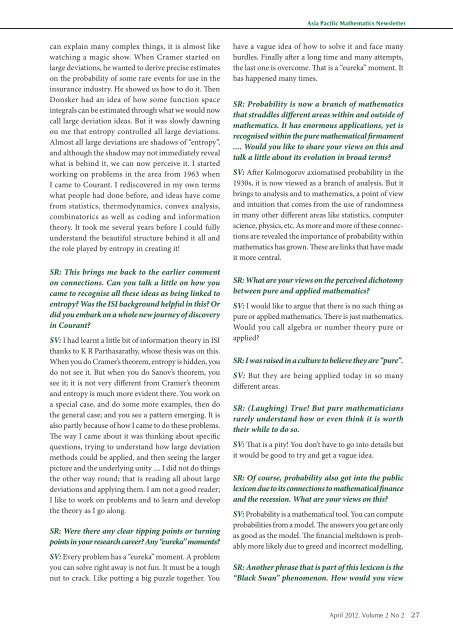Mathematics Newsletter
Mathematics Newsletter
Mathematics Newsletter
Create successful ePaper yourself
Turn your PDF publications into a flip-book with our unique Google optimized e-Paper software.
can explain many complex things, it is almost like<br />
watching a magic show. When Cramer started on<br />
large deviations, he wanted to derive precise estimates<br />
on the probability of some rare events for use in the<br />
insurance industry. He showed us how to do it. Then<br />
Donsker had an idea of how some function space<br />
integrals can be estimated through what we would now<br />
call large deviation ideas. But it was slowly dawning<br />
on me that entropy controlled all large deviations.<br />
Almost all large deviations are shadows of “entropy”,<br />
and although the shadow may not immediately reveal<br />
what is behind it, we can now perceive it. I started<br />
working on problems in the area from 1963 when<br />
I came to Courant. I rediscovered in my own terms<br />
what people had done before, and ideas have come<br />
from statistics, thermodynamics, convex analysis,<br />
combinatorics as well as coding and information<br />
theory. It took me several years before I could fully<br />
understand the beautiful structure behind it all and<br />
the role played by entropy in creating it!<br />
SR: This brings me back to the earlier comment<br />
on connections. Can you talk a little on how you<br />
came to recognise all these ideas as being linked to<br />
entropy? Was the ISI background helpful in this? Or<br />
did you embark on a whole new journey of discovery<br />
in Courant?<br />
SV: I had learnt a little bit of information theory in ISI<br />
thanks to K R Parthasarathy, whose thesis was on this.<br />
When you do Cramer’s theorem, entropy is hidden, you<br />
do not see it. But when you do Sanov’s theorem, you<br />
see it; it is not very different from Cramer’s theorem<br />
and entropy is much more evident there. You work on<br />
a special case, and do some more examples, then do<br />
the general case; and you see a pattern emerging. It is<br />
also partly because of how I came to do these problems.<br />
The way I came about it was thinking about specific<br />
questions, trying to understand how large deviation<br />
methods could be applied, and then seeing the larger<br />
picture and the underlying unity .... I did not do things<br />
the other way round; that is reading all about large<br />
deviations and applying them. I am not a good reader;<br />
I like to work on problems and to learn and develop<br />
the theory as I go along.<br />
SR: Were there any clear tipping points or turning<br />
points in your research career? Any “eureka” moments?<br />
SV: Every problem has a “eureka” moment. A problem<br />
you can solve right away is not fun. It must be a tough<br />
nut to crack. Like putting a big puzzle together. You<br />
Asia Pacific <strong>Mathematics</strong> <strong>Newsletter</strong><br />
have a vague idea of how to solve it and face many<br />
hurdles. Finally after a long time and many attempts,<br />
the last one is overcome. That is a “eureka” moment. It<br />
has happened many times.<br />
SR: Probability is now a branch of mathematics<br />
that straddles different areas within and outside of<br />
mathematics. It has enormous applications, yet is<br />
recognised within the pure mathematical firmament<br />
.... Would you like to share your views on this and<br />
talk a little about its evolution in broad terms?<br />
SV: After Kolmogorov axiomatised probability in the<br />
1930s, it is now viewed as a branch of analysis. But it<br />
brings to analysis and to mathematics, a point of view<br />
and intuition that comes from the use of randomness<br />
in many other different areas like statistics, computer<br />
science, physics, etc. As more and more of these connections<br />
are revealed the importance of probability within<br />
mathematics has grown. These are links that have made<br />
it more central.<br />
SR: What are your views on the perceived dichotomy<br />
between pure and applied mathematics?<br />
SV: I would like to argue that there is no such thing as<br />
pure or applied mathematics. There is just mathematics.<br />
Would you call algebra or number theory pure or<br />
applied?<br />
SR: I was raised in a culture to believe they are “pure”.<br />
SV: But they are being applied today in so many<br />
different areas.<br />
SR: (Laughing) True! But pure mathematicians<br />
rarely understand how or even think it is worth<br />
their while to do so.<br />
SV: That is a pity! You don’t have to go into details but<br />
it would be good to try and get a vague idea.<br />
SR: Of course, probability also got into the public<br />
lexicon due to its connections to mathematical finance<br />
and the recession. What are your views on this?<br />
SV: Probability is a mathematical tool. You can compute<br />
probabilities from a model. The answers you get are only<br />
as good as the model. The financial meltdown is probably<br />
more likely due to greed and incorrect modelling.<br />
SR: Another phrase that is part of this lexicon is the<br />
“Black Swan” phenomenon. How would you view<br />
April 2012, Volume 2 No 2 27


